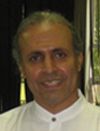Seismic imaging: Kirchhoff, beam, WEM, RTM, anisotropy, what is next?
OR
About the Course
SEG members, view the course for free!
2011 SEG Honorary Lecturer Middle East and Africa. The lecture will include three parts:
- Seismic imaging made easy, really easy
- What do we learn from the past?
- The current status and the road ahead
Seismic imaging (migration) is arguably the single most important step in treating recorded seismic data; it is usually the "final say" in processing and it has contributed, single-handedly, to some of the most important finds in the petroleum industry. This wave-equation-based operation has typically the biggest influence on seismic data and, as a result, costs the most. It is also sadly responsible for the most acronyms (abbreviations) used in the seismic industry, which is sometimes confusing.
Any process that moves (migrates) the reflection (or scattered) energy of seismic data can be referred to as migration, with imaging accomplished through imposing the imaging conditions. Those are zero-offset and zero-time, applied separately in poststack migration, but, now commonly applied simultaneously in what is referred to as prestack imaging. Seismic-imaging algorithms can be divided into two broad categories: integral methods (e.g., Kirchhoff methods) and wavefield-continuation methods. Integral methods can be described by simple geometrical objects such as rays and summation surfaces. Wavefield-continuation methods can yield more accurate images of complex subsurface structures.
In the 1980s, the integral approach was king; its simplicity and adaptability made it the industry workhorse through the 1990s, where it was used mostly on 3D data. It also provided an explicit approach to evaluate the accuracy of the velocity model used in the prestack migration by allowing the offsets to be handled separately. Meanwhile, direct-wave (continuation) methods, despite their potential, were still just gaining their footing at the time and were used mostly in poststack migration utilizing the velocity-inhomogeneity-limited Fourier methods or the dip-limited depth extrapolators. In the late 1990s, a slew of wave-equation-migration (WEM) results, especially in 3D subsalt regions, revealed some of the power of this technique. This was helped with the advent of velocity verification methods for WEM such as subsurface offset gathers (SOCIG) and angle gathers (ADCIG). The reign of WEM, however, was short lived; as our computing capabilities matured, short-changing the wave equation was no longer required and reverse time migration (RTM) saw a huge revival in the first decade of the 21st century. From acoustic isotropic RTM, to acoustic VTI (vertically transversely isotropic), and finally acoustic and elastic TTI (tilted transversely isotropic), the sky was the limit. RTM, however, remains too expensive for velocity estimation processes, and thus, curvelets, beam, and other fast methods are still used widely. RTM also has a weakness imposed by the integral-based imaging condition.
Further advances in computing nevertheless will make more complicated methods feasible, and thus we have to prepare for them. A more complicated wave equation describing wavefield evolution in the prestack domain, with the wavefield given as a function of three independent parameters in 2D media and five in 3D, can help alleviate some of the limitations of RTM. The double square-root (DSR) equation provides us with such a formula; the challenge is to resolve the limitations of this equation. While most modern seismic imaging techniques perform imaging by separating input data into parts (shot gathers), this new formulation is able to incorporate all available data at once, while numerically propagating the recorded multi-dimensional wavefield backward in time. While computationally intensive, this approach has the potential of generating accurate images, free of artifacts associated with RTM. Also, unlike RTM, which requires an integral-based imaging condition, imaging using the double square-root equation avoids that requirement and thus provides an explicit relationship between the imaging operator and medium parameters. A numerical extrapolation shows the evolution of the wavefield in the prestack domain using a prestack exploding reflector modeling and migration (PERM) experiment.
Your Instructor

Tariq A. Alkhalifah is a professor of geophysics in the division of Physical Sciences and Engineering at King Abdullah University for Science and Technology (KAUST). He assumed his duties there in June 2009. Prior to joining KAUST, Tariq was a research professor and director of the Oil and Gas Research Institute at King Abdulaziz City for Science & Technology (KACST). He has also been associate research professor, assistant research professor and research assistant at KACST. From 1996 to 1998, Tariq served as a postdoctoral researcher for the Stanford Exploration Project at Stanford University, USA. He received the J. Clarence Karcher Award from the Society of Exploration Geophysicists (SEG) in 1998 and the Conrad Schlumberger Award from the European Association for Geoscientists and Engineers (EAGE) in 2003. He is a member of SEG and EAGE.
Tariq received his doctoral degree in geophysics (1997) and master's degree (1993) in geophysical engineering from the Colorado School of Mines, USA. He holds a bachelor's degree (1988) in geophysics from King Fahd University of Petroleum and Minerals, Saudi Arabia. Tariq's research interests are in imaging and velocity model building for exploration seismic data with special emphasis on media that exhibit anisotropic behavior.
